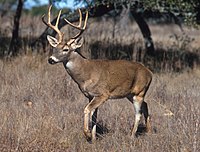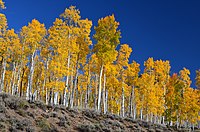
Mule deer fawn recruitment dynamics in an energy disturbed landscape
Sign Up to like & getrecommendations! Published in 2023 at "Ecology and Evolution"
DOI: 10.1002/ece3.9976
Abstract: Abstract Wildlife population dynamics are modulated by abiotic and biotic factors, typically climate, resource availability, density‐dependent effects, and predator–prey interactions. Understanding whether and how human‐caused disturbances shape these ecological processes is helpful for the conservation… read more here.
Keywords: density; fawn fall; weather; mule deer ... See more keywords

Mule Deer Habitat Selection Following Vegetation Thinning Treatments in New Mexico
Sign Up to like & getrecommendations! Published in 2020 at "Wildlife Society Bulletin"
DOI: 10.1002/wsb.1062
Abstract: Mule deer (Odocoileus hemionus) survival and population growth in north‐central New Mexico, USA, was previously reported to be limited by nutritional constraints due to poor forage conditions in degraded habitats. Management recommendations suggested thinning of… read more here.
Keywords: deer; mule deer; habitat selection; vegetation ... See more keywords

Energy development and hunter success for mule deer and pronghorn in Wyoming
Sign Up to like & getrecommendations! Published in 2017 at "Wildlife Society Bulletin"
DOI: 10.1002/wsb.728
Abstract: Infrastructure associated with energy development influences hunter access and introduces disturbance activities to landscapes that can influence habitat selection and behavior of ungulates. Consequently, habitat loss and hunter access concerns must be addressed by wildlife… read more here.
Keywords: mule deer; deer pronghorn; mule; energy development ... See more keywords

Susceptibility of spring‐flowering garden plants to herbivory by mule deer
Sign Up to like & getrecommendations! Published in 2018 at "Wildlife Society Bulletin"
DOI: 10.1002/wsb.864
Abstract: Many people look forward to spring flowers, only to discover that mule deer (Odocoileus hemionus) have eaten the sprouting plants and flower buds. One potential method to prevent this problem is to grow unpalatable flowering… read more here.
Keywords: deer; mule deer; flowering plants; spring ... See more keywords

Does condition of adult male cervids reflect condition of adult females? A test with mule deer
Sign Up to like & getrecommendations! Published in 2021 at "Mammal Research"
DOI: 10.1007/s13364-021-00579-2
Abstract: Body condition integrates the effects of habitat on individuals and consequently population performance of cervids. However, most condition data is likely to come from harvested males, which may not reflect absolute condition of, or habitat… read more here.
Keywords: adult; mule deer; adult females; condition ... See more keywords

Forest restoration, wildfire, and habitat selection by female mule deer
Sign Up to like & getrecommendations! Published in 2019 at "Forest Ecology and Management"
DOI: 10.1016/j.foreco.2019.05.067
Abstract: Abstract Decades of fire suppression, logging, and overgrazing have led to increased densities of small diameter trees which have been associated with decreases in biodiversity, reduced habitat quality for wildlife species, degraded foraging conditions for… read more here.
Keywords: forest restoration; wildfire; habitat; mule deer ... See more keywords

Factors affecting the selection of and displacement within core areas by female mule deer (Odocoileus hemionus) in the Chihuahuan Desert, Mexico
Sign Up to like & getrecommendations! Published in 2017 at "Mammalian Biology"
DOI: 10.1016/j.mambio.2017.08.005
Abstract: Abstract Core activity areas are the most important sites within an animal’s home range as they contain the greatest density of critical resources. Because these areas are small and intensively used, they can affect the… read more here.
Keywords: deer; mule deer; selection; female mule ... See more keywords

Influence of Precipitation and Crop Germination on Resource Selection by Mule Deer (Odocoileus hemionus) in Southwest Colorado
Sign Up to like & getrecommendations! Published in 2017 at "Scientific Reports"
DOI: 10.1038/s41598-017-15482-7
Abstract: Mule deer (Odocoileus hemionus) populations in the western United States provide many benefits to local economies but can also cause considerable damage to agriculture, particularly damage to lucrative crops. Limited information exists to understand resource… read more here.
Keywords: mule deer; resource selection; crop; deer ... See more keywords

Variation in movement patterns of mule deer: have we oversimplified migration?
Sign Up to like & getrecommendations! Published in 2021 at "Movement Ecology"
DOI: 10.1186/s40462-021-00281-7
Abstract: Background Conservation and management of migratory animals has gained attention in recent years, but the majority of research has focused on stereotypical ‘migrant’ and ‘resident’ behaviors, often failing to incorporate any atypical behaviors or characterize… read more here.
Keywords: deer; variation; migratory; range ... See more keywords

Endemic chronic wasting disease causes mule deer population decline in Wyoming
Sign Up to like & getrecommendations! Published in 2017 at "PLoS ONE"
DOI: 10.1371/journal.pone.0186512
Abstract: Chronic wasting disease (CWD) is a fatal transmissible spongiform encephalopathy affecting white-tailed deer (Odocoileus virginianus), mule deer (Odocoileus hemionus), Rocky Mountain elk (Cervus elaphus nelsoni), and moose (Alces alces shirasi) in North America. In southeastern… read more here.
Keywords: deer; cwd; mule deer; disease ... See more keywords

Mule deer impede Pando’s recovery: Implications for aspen resilience from a single-genotype forest
Sign Up to like & getrecommendations! Published in 2018 at "PLoS ONE"
DOI: 10.1371/journal.pone.0203619
Abstract: Aspen ecosystems (upland Populus-dominated forests) support diverse species assemblages in many parts of the northern hemisphere, yet are imperiled by common stressors. Extended drought, fire suppression, human development, and chronic herbivory serve to limit the… read more here.
Keywords: mule deer; pando; regeneration; genotype ... See more keywords